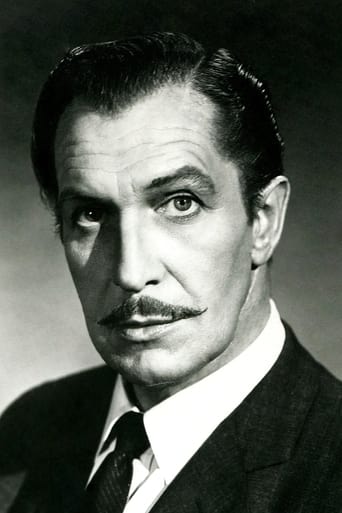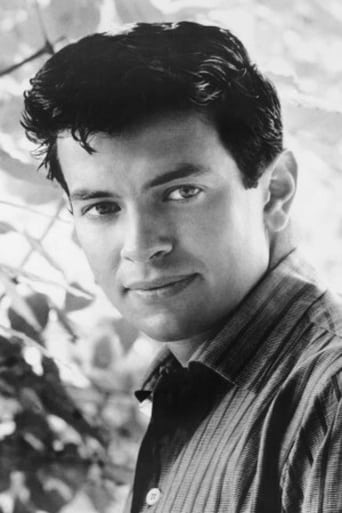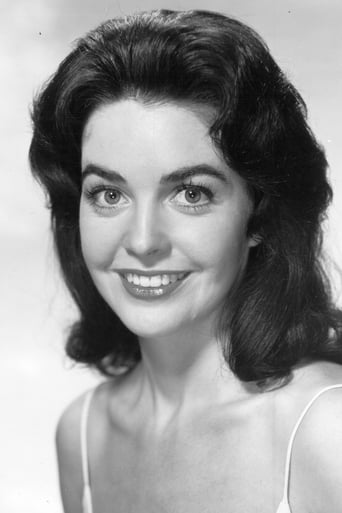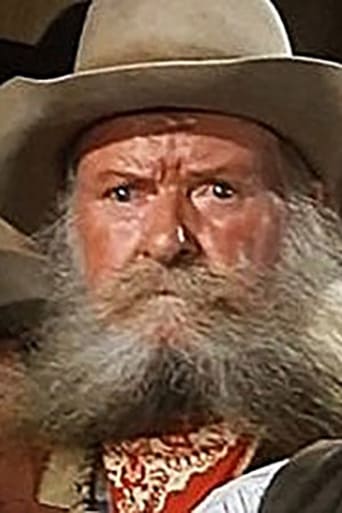Cathardincu
Surprisingly incoherent and boring
SpuffyWeb
Sadly Over-hyped
Smartorhypo
Highly Overrated But Still Good
Sanjeev Waters
A movie that not only functions as a solid scarefest but a razor-sharp satire.
dougdoepke
I don't know about Poe, but the movie's something of a disappointment. Producer-director Corman had a bigger budget than usual to work with, and it's evident he sank most of it into the sumptuous mansion sets. On one level, they're quite impressive as is Price as the afflicted Roderick Usher. Price's aristocratic bearing is perfect for the overbearing part. However, two things work against the horror effects. First are the sets that are so sumptuous, they distract visually from the downward spiral of the characters. This is a psychological melodrama. Thus, the visuals should complement and not compete with the story. Second is the high-key lighting that brings out the vivid colors, again a visual distraction. They're eye-catching, but they also split the background from the rather one- note story. There's a reason that the horror classics go back to the era of low-key b&w. With that cinematography, shades and shadows could be easily merged into feelings of anguish and dread. Here, the musical score and overdone sound effects are piled on as nudging compensation. But unfortunately they're more annoying, than complementary.On the plus side, are Price and Fahey as the ill-fated brother and sister. At the same time, however, Damon appears to lack the gravitas to go up against the formidable Roderick and the accursed house. Still, I thought the spirit apparitions sequence was truly creepy and made me think Herk Harvey of that minor masterpiece Carnival of Souls (1962) may have used it as inspiration. On the whole, however, the movie strikes me as overrated, more of a visual experience than a shuddery one. I expected better.
stones78
I wouldn't call this a strict horror film, although it has some small elements of horror, but the atmosphere alone, plus the performance of the great Vincent Price(Roderick Usher)is worthy enough to recommend this film. You know the story by now, and even though it takes a little time to progress, it's worth the wait, and you don't need to be a horror fan to enjoy. My personal highlight is the performance of Harry Ellerbe, who portrayed Bristol the butler, as he tried his best to appease all the parties involved, and was very proper and respectful, and it's easy "root" for him, so to speak. The color schemes worked very well, as it was also a fine movie to look at visually, even though the exterior of the castle's many shots were obviously fake, and even some of Price's lines were pretentious, but still charming. Mark Damon(Philip Winthrop)and Myrna Fahey(Madeline Usher)were both solid in their prospective roles, even though at times their dialog was a tad mushy. The conclusion of this film was better than I remembered it being, and that adds to what is a solid film which boasts the talents of one Vincent Price.
ironhorse_iv
Edgar Allan Poe is one of the greatest writers of all time, and House of Usher (1960) the film version of his short story "The Fall of the House of Usher" is interesting look at modern psychological science. It covers the form of sensory overload known as hyperesthesia (hypersensitivity to light, sounds, smells, and tastes), hypochondria (an excessive preoccupation or worry about having a serious illness), and acute anxiety. The film was directed by Roger Corman known for his Edgar Allan Poe adaptations. The film was the first of eight Corman/Poe feature films. The film starts with Philip Winthrop (Mark Damon) travels to the House of Usher, , to meet his fiancée Madeline Usher (Myrna Fahey). Madeline's brother Roderick (Vincent Price) doesn't want the marriage to happen, telling Phillip that the Usher family is afflicted by a cursed bloodline which has driven all their ancestors to madness and doesn't want that to continue. Victor Price is great in the role, and truly can seem like a hypochondriac madman. Philip becomes increasingly desperate to take Madeline away; but Madeline suddenly dies and laid to rest in the family crypt beneath the house. As Philip is preparing to leave, the butler, Bristol (Harry Ellerbe), lets slip that Madeline is alive. Philip rips open Madeline's coffin and finds it empty. He desperately searches for her in the winding passages of the crypt but she eludes him and confronts her brother. Now completely insane, Madeline avenges herself upon the brother who knowingly buried her alive. The film does a good job in my opinion of presenting a faithful adaption of Edgar Allan Poe's classic tale of the macabre. Others say it ignore the author's style. I do say I'm glad the film doesn't do a whole reading of Mad Tryst, a novel in Poe's novel "House of Usher'. It wasn't needed in the film. The use of color is wondering. I love the opening shot of Victor Price in the bright red suit. Chilling—yet there were a bit of over cheese scenes, such as that of the green fog and dead people that makes me laugh. That scene was probably a serious scene in 1960's, but now it does looks awful. The movie help define the Gothic genre. It shows Poe's ability to create an emotional tone in his work, specifically feelings of fear, doom, and guilt. The explicit psychological dimension of this tale has prompted many critics to analyze it as a description of the human psyche, comparing, for instance, the House to the unconscious, and its central crack to the personality split which is called dissociative identity disorder. Mental disorder is also evoked through the themes of melancholy, and possible incest. An incestuous relationship between Roderick and Madeline is never explicitly stated, but seems implied by the strange attachment between the two. The film can be interpreted as "a detailed account of the derangement and dissipation of an individual's personality." The house itself becomes the "symbolic embodiment of this individual." With the house falling apart, the characters are falling as well. Check it out if you want. There are two versions, the original and the retouch version, as on 2010, BRIC Arts presented the film with a new score and psychedelic overlays and flash forwards by Marco Benevento in celebration of the film's 50th anniversary. I would choose the newer version as it's more interesting in sound and taste. A great horror movie, so watch it. Talked about a really good haunted house movie.
James Hitchcock
"The Fall of the House of Usher" was the first in a cycle of films based on the works of Edgar Allen Poe and made by Roger Corman between 1960 and 1964. (All but one of these starred Vincent Price). As with some of the later entries in the series, Corman makes a number of changes to Poe's story. Poe never explicitly states where the action of his story takes place, but his references to the house being many centuries old suggest a location somewhere in Britain. (In his lifetime few American houses would have been older than a century, and none older than two centuries). The film, however, is explicitly set in New England, with the explanation that the house was dismantled and re-erected across the Atlantic when the Ushers emigrated. Poe's nameless narrator is invited to the house as a boyhood friend of its owner, Roderick Usher. Here he is given the name Philip Winthrop and is the fiancé of Roderick's sister Madeline. In the story Roderick and Madeline are twins, but here Roderick is a middle-aged man considerably older than either his sister or Philip. In the original Madeline only appears briefly before her death, but here she is given a more important role. Most importantly, Corman introduces a moral theme not found in Poe. (He was to do something similar in a later Poe film "The Masque of the Red Death", where the innocent young girl Francesca is introduced so that her goodness can act as a foil to the villainy of Duke Prospero).Poe's Ushers were a distinguished family, noted for their charity and their patronage of the arts; there is nothing to suggest that the decline in their fortunes is in any way connected with their moral character. Here, Roderick and Madeline are the last survivors of a family notorious for wickedness, cruelty and vice, many of whom went mad, and it is implied that their evil has blighted the surrounding countryside and suffused the very walls of the house itself. Poe used the phrase "fall of the house" in a double sense, referring to both the decline of the family and the physical collapse of their home. The film does the same, but with the implication that this "fall" is the natural result of, and a just reward for, centuries of evil living. Despite its divergences from Poe's plot, however, the film still keeps an essential feature of his story, namely the atmosphere of psychological terror which pervades it. Much of this is due to the performance of Vincent Price (Neither Mark Damon as Philip nor Myrna Fahey as Madeline makes much of an impression). Like Poe's character, Price's Roderick is a man prey to all sorts of fears- he is hypersensitive, a hypochondriac, obsessed with the evil deeds of his ancestors and tormented by the idea that, like them, he is doomed to madness. He believes firmly that if Philip succeeds in his intention of taking Madeline away from the house some unspecified evil will follow. The Madeline we see in this film, unlike her counterpart in the original story, initially seems physically and mentally healthier than her brother, but it quickly becomes clear that she has health problems of her own, and that she may also be in danger from another source.This was the first film which the studio, American International Pictures, made in colour. AIP had only been founded six years earlier, and had hitherto specialised in low-budget black-and-white movies, often aimed at the teenage market. "The Fall of the House of Usher" was made on a rather higher budget than most earlier AIP films (although still lower than the average film of this period) and was clearly aimed at a more prestigious market. In some of his later Poe adaptations, such as "The Masque of the Red Death", Corman was to reveal himself as a master colorist, but here the use of colour does not really add anything, and it struck me that this is a film which might have been better had it been made in black-and-white. Certainly, monochrome photography was becoming unfashionable in the American cinema in the early sixties, but films like "The Haunting" from three years later show that it was still possible to make effective black-and-white horror movies during this period, and Poe's story might have benefited from a similar expressionist treatment. The exterior scenes of the old house might also have seemed more convincing in black-and-white. Another visual element I disliked was those curious paintings of Roderick's ancestors, as their crude, modernistic style seemed very inappropriate given that the action is supposed to take place during the 1830s or 1840s. "The Fall of the House of Usher" has some similarities with the last film in the Poe-Corman cycle, "The Tomb of Ligeia"; in both films there is a certain ambiguity as to whether the characters really are threatened by supernatural evils or whether these evils only exist as fears in the mind of the Vincent Price character (called Verden Fell in the later film). I would not rate it quite as highly as "The Masque of the Red Death", but overall, it is a pretty good film, a good example of the "understated" style of horror. ("The Haunting" is another such). The actual horrors which we see on screen are less important than the unnamed horrors which are hinted at but not shown directly. 7/10










